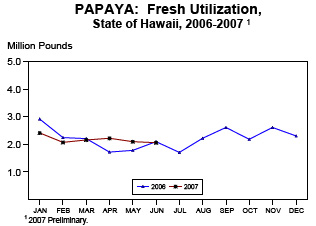Here is the PDF file for the *Hawaii Monthly Livestock Review* Report.
lvstk071207.pdf
Please visit the website for more information: http://www.nass.usda.gov/hi/
————————————————————-
Contact Information:
Mark E. Hudson, Director
USDA NASS Hawaii Field Office
1421 South King Street
Honolulu, HI 96814-2512
Office: (808) 973-9588 / (800) 804-9514
Fax: (808) 973-2909
————————————————————-
“HAWAII MONTHLY LIVESTOCK REVIEW” reports are available on our website http://www.nass.usda.gov/hi/ and also PRINTED monthly. Subscriptions for PRINTED copies are free to those persons who report agricultural data to NASS (upon request) and available for $4 per year to all others.
May Egg Production Down 17 Percent From A Year Ago
Hawaii egg production totaled 6.9 million (19,167 cases) in May 2007, down 17 percent from May 2006. The average number of layers on hand during May 2007 was estimated at 367,000, down 3 percent from April 2007 and down 18 percent from May 2006. The average rate of lay during May 2007 was 1,880 per 100 layers (60.6 percent rate of lay), up 1 percent from May 2006
May Cattle Marketings Up 10 Percent From 2006
Total cattle marketings for May 2007 is estimated at 7,500 head, up 10 percent from May 2006. Cumulative cattle marketings for 2007 through May totaled 24,000 head, down 1 percent from the same period a year ago.
May exports up 12 percent from year ago
Exports of steers and heifers totaled 6,500 head in May 2007, up 12 percent from a year ago. Exports of steers totaled 3,900 head during May 2007, 3 percent higher than a year ago. Total export of heifers was also higher in May 2007 compared to a year ago at 2,600 head, a 30 percent increase. Cumulative exports for 2007 totaled 19,500 head of steers and heifers through May, down 2 percent from the same period a year ago. Cumulative exports of steers for 2007 stands at 11,500 head, down 1 percent from 2006. Exports of heifers showed a larger decrease through the first five months of 2007 at 8,000 head or down 4 percent from a year ago. Exports of other classes of cattle were not included.
Average live weight up 2 percent
The average live weight of steers and heifers exported from Hawaii in May 2007 was 418 pounds, up 2 percent from May 2006?s average live weight of 412 pounds.
Commercial Beef Production Up 5 Percent
Hawaii commercial beef production (local slaughter) during May 2007 totaled 582,000 pounds, up 5 percent from May 2006. Cumulative beef production (local slaughter) through May 2007 totaled 2.6 million pounds, up 7 percent from a year ago. Commercial kill totaled 1,000 head in May, unchanged from May 2006. Average live weight per head was 1,085 pounds in May 2007, up 6 percent from the average live weight per head in May 2006.
Commercial Pork Production Down 5 Percent
Hawaii commercial pork production during May 2007 totaled 316,000 pounds, down 5 percent from May 2006. Cumulative pork production for the first five months of 2007 totaled 1.4 million pounds, down 7 percent from a year ago. Total hog kill was 1,900 head in May 2007, down 5 percent from a year ago. Average live weight per head was 219 pounds in May 2007, down 4 percent from the 227-pound average a year ago.
May Milk Production Down 35 Percent From Year Ago
Hawaii?s dairy cows produced 3.3 million pounds of milk in May 2007, down 35 percent from a year ago. Cumulative milk production for the first five months of 2007 totaled 18.9 million pounds, down 25 percent from the same period in 2006.
May?s Cow Herd Down 26 Percent From Year Ago
Hawaii?s cow herd, both dry and milking, numbered 3,200 head in May 2007, unchanged from April 2007 but down 26 percent from May 2006. Average milk per cow is estimated at 1,020 pounds for May 2007, down 14 percent from last May?s average of 1,185 pounds per cow.
Average Farm Prices
Most Livestock Prices Remain Higher Than Year-ago Averages
Steers and heifers
The average dress weight farm price for steers and heifers is estimated at 99.0 cents per pound for May 2007, down 1 percent from April 2007 but unchanged compared to a year ago.
Cows
The average dress weight farm price for cows is estimated at 55.0 cents per pound in May 2007, up 2 percent from April. Compared to a year ago, the average dress weight farm price for cows was up a penny from May 2006.
Market hogs
The average dress weight farm price for market hogs is estimated at $1.17 per pound for May 2007, down 2 percent from April 2007. Compared to a year ago, the dressed weight for market hogs was down 8 percent this May.
Milk
The average farm price for milk was $27.40 per hundredweight during May 2007, up 1 percent from April 2007. Compared to a year ago, the May 2007 average farm price for milk was 10 percent higher.
Eggs
The average farm price for a dozen eggs was $1.12 in May 2007, up 2 percent from April 2007 and 14 percent higher than a year ago.
 JUNE FRESH PAPAYA OUTPUT LOWER
JUNE FRESH PAPAYA OUTPUT LOWER
